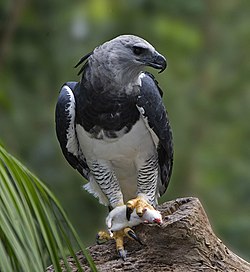| Harpiinae | |
|---|---|
 | |
| Harpy eagle (H. harpyja) | |
| Scientific classification | |
| Kingdom: | Animalia |
| Phylum: | Chordata |
| Class: | Aves |
| Order: | Accipitriformes |
| Family: | Accipitridae |
| Subfamily: | Harpiinae Verheyen, 1959 [1] [2] |
The Harpiinae is a bird of prey subfamily which consists of large broad-winged species native to tropical forests, sometimes collectively known as harpies (not to be confused with the mythological creature of the same name). There are 4 genera in the subfamily, all monotypic. [3] [4]
The cladogram of the Harpiinae shown below is based on a molecular phylogenetic study of the Accipitridae by Therese Catanach and collaborators that was published in 2024. [5]
| Harpiinae |
| ||||||||||||



